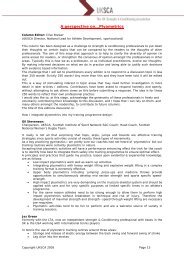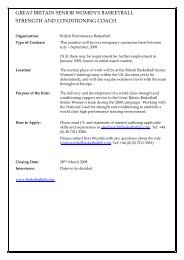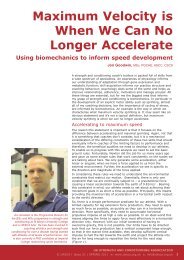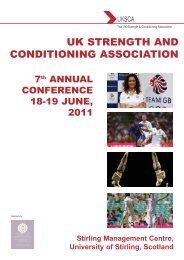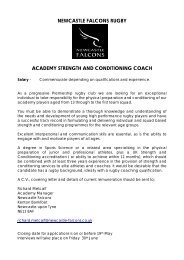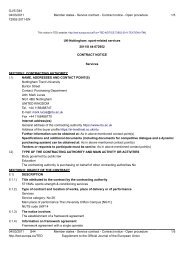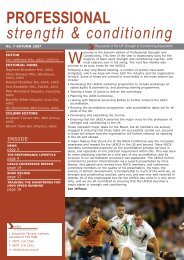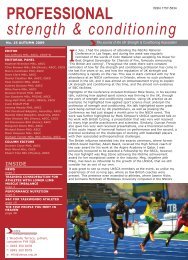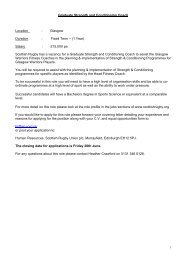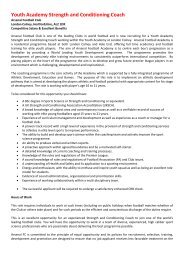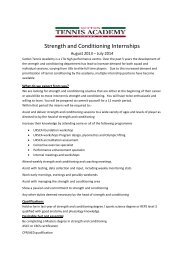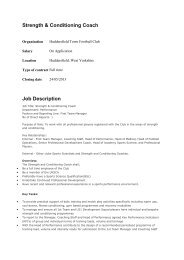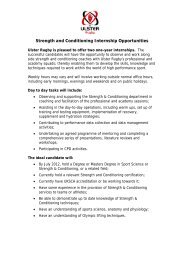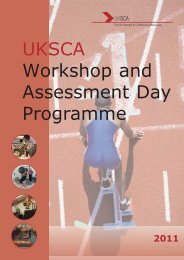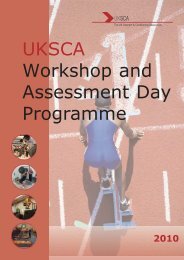uksca news june 2010.qxp
uksca news june 2010.qxp
uksca news june 2010.qxp
Create successful ePaper yourself
Turn your PDF publications into a flip-book with our unique Google optimized e-Paper software.
of time. However, poor planning and application of concurrent<br />
training can lead to negative effects on desired performance<br />
characteristics. 7,29<br />
When producing a plan for team sports, concurrent training is likely<br />
to be unavoidable during the in-season, and therefore the<br />
interference effects of training objectives must be carefully<br />
considered. An example is training for hypertrophy while<br />
simultaneously training for aerobic power. Hypertrophy training<br />
would attempt to increase protein synthesis in the muscle, causing<br />
considerable hormonal and metabolic stress at a cellular level.<br />
However, simultaneously training for aerobic power requires the<br />
muscle to increase it oxidative capacity, 23 and can reduce muscle<br />
protein synthesis due to cellular signalling mechanisms. These are<br />
two contradictory adaptations, and cause an interference effect. In<br />
determining the best approach, the strength and conditioning<br />
practitioner must consider the neuromuscular, metabolic and<br />
hormonal stress placed on the body from each competition, training<br />
session and training objective, and how these interact when<br />
performed concurrently. When all variables have been considered,<br />
the strength and conditioning practitioner can plan and implement a<br />
training plan over a long, medium and short term period with<br />
optimal effect for the sports annual training plan.<br />
Summary<br />
Although much resistance has been documented towards a classic<br />
model of periodisation, much of this is unwarranted due to<br />
misinterpretation of Matveyev’s initial concept. Matveyev did not<br />
intend this model to be used rigidly, and evolution of the classic<br />
model has allowed for its application in many different settings,<br />
even though these evolutions are very similar to the original model.<br />
The key concepts the strength and conditioning practitioner should<br />
consider when constructing a periodised plan are:<br />
1) Is there a systematic method of planning and application?<br />
2) Are training characteristics planned and applied appropriately to<br />
allow for optimal adaptation?<br />
3) Does the plan optimise the biological adaptive process of the<br />
human body through the short and long term plan?<br />
Figure 1. An example Mesocycle and<br />
Microcycle over a 4 week period of a<br />
team sport competition calendar A<br />
= Accumulation, T= Transmutation<br />
RL= Realization, M = Match, R=<br />
Recovery.<br />
References<br />
1. Allerheiligen, B. (2003) In season<br />
strength training for power athletes.<br />
Strength and Conditioning Journal,<br />
25 (3): 23-28.<br />
2. Baker, D. (1998) Applying the inseason<br />
periodization of strength<br />
and power training to football.<br />
Strength and Conditioning Journal,<br />
20 (2): 18-24.<br />
3. Baker, D. (2001) The effects of an<br />
in season of concurrent training on<br />
the maintenance of maximal<br />
strength and power in professional<br />
and college aged rugby league<br />
football players. Journal of Strength<br />
and Conditioning Research, 15 (2):<br />
172-177.<br />
4. Baker, D. (2007) Cycle length<br />
variants in periodized strength/<br />
power training. Strength and<br />
Conditioning Journal, 29 (4): 10-17.<br />
5. Bondarchuk, A. (1994) The role and<br />
sequence of using different training<br />
load intensities. Fitness and Sports<br />
Review International, 29: 202-204.<br />
UK STRENGTH AND CONDITIONING ASSOCIATION<br />
© UKSCA | Issue 18 | Summer 2010 w: www.<strong>uksca</strong>.org.uk e: info@<strong>uksca</strong>.org.uk 9



